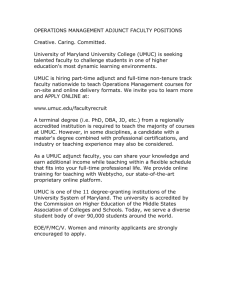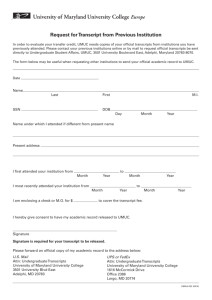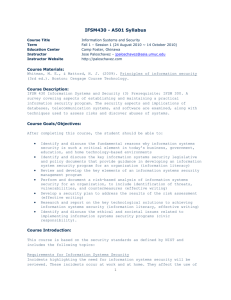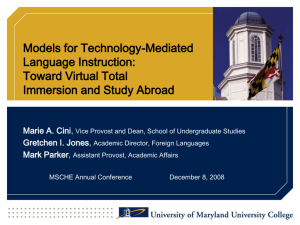Research Exercise - Peaceful Creature Peaceful Creature
advertisement
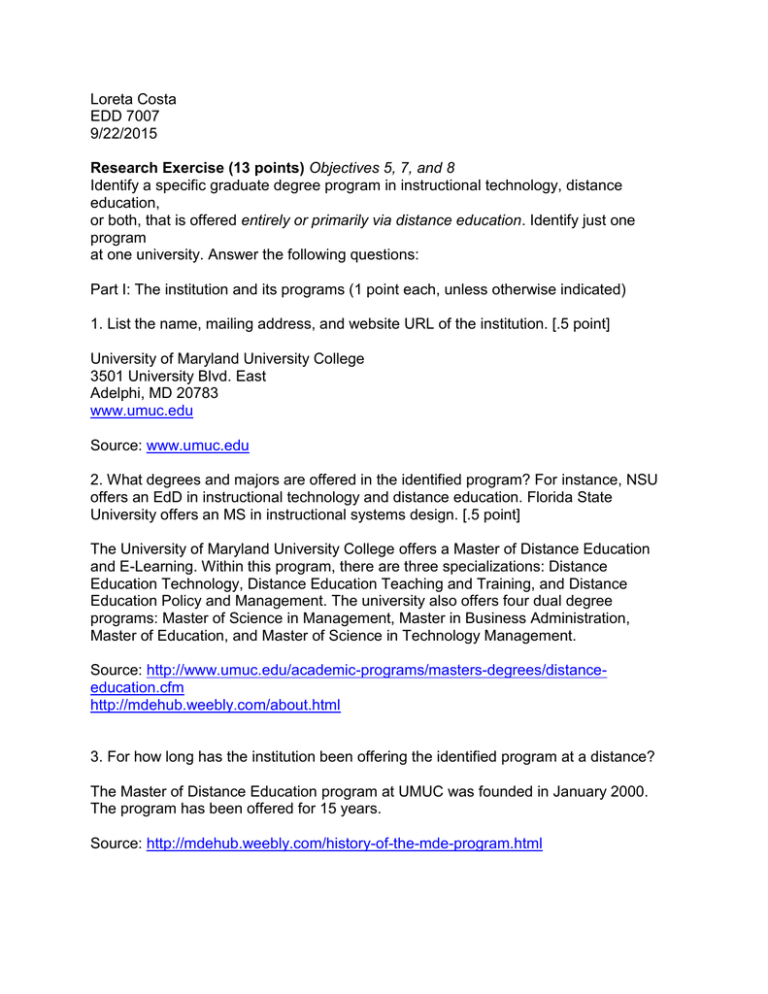
Loreta Costa EDD 7007 9/22/2015 Research Exercise (13 points) Objectives 5, 7, and 8 Identify a specific graduate degree program in instructional technology, distance education, or both, that is offered entirely or primarily via distance education. Identify just one program at one university. Answer the following questions: Part I: The institution and its programs (1 point each, unless otherwise indicated) 1. List the name, mailing address, and website URL of the institution. [.5 point] University of Maryland University College 3501 University Blvd. East Adelphi, MD 20783 www.umuc.edu Source: www.umuc.edu 2. What degrees and majors are offered in the identified program? For instance, NSU offers an EdD in instructional technology and distance education. Florida State University offers an MS in instructional systems design. [.5 point] The University of Maryland University College offers a Master of Distance Education and E-Learning. Within this program, there are three specializations: Distance Education Technology, Distance Education Teaching and Training, and Distance Education Policy and Management. The university also offers four dual degree programs: Master of Science in Management, Master in Business Administration, Master of Education, and Master of Science in Technology Management. Source: http://www.umuc.edu/academic-programs/masters-degrees/distanceeducation.cfm http://mdehub.weebly.com/about.html 3. For how long has the institution been offering the identified program at a distance? The Master of Distance Education program at UMUC was founded in January 2000. The program has been offered for 15 years. Source: http://mdehub.weebly.com/history-of-the-mde-program.html 4. What course delivery technologies are used? Be specific: general terms such as “Webbased” are insufficient. Also, be inclusive, bearing in mind that many programs use a variety of technologies in addition to a course management system. The program at UMUC partners with the Center for Lifelong Learning at the Carl von Ossietzky University of Oldenburg (OL), which is one of the oldest distance learning universities in the world, having been founded in 1974. Because of this partnership, UMUC’s Master of Distance Education and E-learning program employs many of the same course delivery technologies, emphasizing asynchronous (different place, different time) learning for maximum flexibility for both students and teachers. Online tutorials (both written and pictorial as well as video/audio) and online seminars composed of threaded discussion posts are used in an organized manner within each course, which is then accessed through course management systems. These technologies are all easily accessible worldwide through the web. Source: http://mdehub.weebly.com/about.html http://mdehub.weebly.com/history-of-the-mde-program.html 5. Is there a face-to-face component of instruction? If so, where is it conducted, and for what duration? There is no face to face interaction in the program. The program prides itself on its asynchronous delivery, which is done fully online in a web-based ‘virtual’ classroom environment. Source: http://mdehub.weebly.com/history-of-the-mde-program.html 6. How long does it take to earn a degree in the identified program? (Indicate either the briefest amount of time required or the amount of time most students require.) The program consists of 36 total credits. These can be completed in as little as two years, which seems to be the most followed degree plan for most students. Source: http://www.umuc.edu/academic-programs/masters-degrees/distanceeducation.cfm http://mdehub.weebly.com/degree-planning.html https://docs.google.com/document/d/1Qx9doOK6jFRGGFpeVGijNJs_Ipf0wpUZjtaaPQmUlA/edit 7. Is the institution accredited? If so, by what organization? [.5 point] The University of Maryland University College is accredited at the regional level by the Middle States Commission on Higher Education and is a member of the University System of Maryland. The Master of Distance Education and E-Learning program also holds specific accreditation from the European Foundation for Management Development-Technology-Enhanced Learning. Source: http://www.umuc.edu/visitors/about/ https://www.umuc.edu/faculty/edudept/eduprograms/mde.cfm 8. Is the institution public or private? If private, is it for-profit or not-for-profit? [.5 point] The University of Maryland University College is a public institution. Source: http://www.umuc.edu/visitors/about/ 9. What is the total enrollment of the institution? How many students are enrolled in the identified distance-delivered program? UMUC’s overall online enrollment surpassed 243,000 students in 2014. Source: https://www.umuc.edu/visitors/about/ipra/glance.cfm 10. What is the tuition (per course or per year)? The Total Tuition for the program depends on your status as either ‘in-state’ or ‘out-ofstate’ resident. For Maryland residents, as well as those in military service and their spouses, the total tuition is $16,488. For out-of-state residents, the total tuition is $23,724. For out-of-state federal employees, their spouses/legal dependents, the total tuition is $17,793. Source: http://www.umuc.edu/academic-programs/masters-degrees/distanceeducation.cfm Be sure to cite your source for each answer. Part II: The institution’s website (1 point each) Critique the institution’s (or program’s) website, answering the following questions: A. How would you rate the visual appeal of the site? What elements are visually appealing, and which aspects are less so? Include screen shot(s) to illustrate. In my opinion, the visual appeal of the site is minimal, comprised of basic, easy to navigate headings and very little in terms of dynamic visuals. Below is the Master of Distance Education and E-Learning main page within the UMUC website, which has low visual appeal: Source: http://www.umuc.edu/academic-programs/masters-degrees/distanceeducation.cfm It includes the most basic information on the program for the prospective student, but adds several buttons and links such as “Request Info” and “Apply Now” that prominently display the most necessary features for students needing additional information. It also provides the phone number for advisors prominently below these two buttons, so that students can speak to a human if they prefer. The most useful link on this page is the one directly underneath the heading, titled “The MDE Hub.” Once you click on that website, you get to the actual program’s self-styled website which contains most of the information on the program: This ‘internal’ website provides more instant visual appeal, by including a large picture of the campus environment so that prospective students feel like they are inquiring about a prestigious institution. Additionally, the buttons on the top of the page break down the various categories and provide more ample information for students. Source: http://mdehub.weebly.com/ B. Is the site easily navigable and well organized? Provide examples. The internal site is well organized, with larger tabs/categories divided into: About, Students, Alumni, and Faculty. Within these tabs, there is ample information with the subsections clearly defined and with tabs for each. Within the “About” section, we can find information on the Master’s Curriculum, Graduate Certificates, Faculty Members, Newsletters, and the Program History. Source: http://mdehub.weebly.com/about.html Clicking on the Master’s Curriculum link gives us more detail and information on the different specializations within the program, which in turn link to additional information for each program: Source: http://mdehub.weebly.com/mde-curriculum.html C. Does the site contain sufficient information to answer questions 1-10? If not, provide details. The internal site (http://mdehub.weebly.com) does a good job of providing most of the information in questions 1-10. It would be useful if the main UMUC program website for this program (http://www.umuc.edu/academic-programs/masters-degrees/distanceeducation.cfm) would stress the importance of the internal MDE Hub website in providing additional information. They simply provide the link but do not stress its importance. D. What is the most positive aspect of the website? The most positive aspect of both websites is the fact that the information is laid out clearly and in an organized matter. Neither website strives for artistic visual appeal, and instead, both approach a no-nonsense method in presenting the information to prospective students. E. What aspect of the site is most in need of improvement? The UMUC website for the program is the probably the initial page that most prospective students come across when researching the university’s distance education programs. If I were designing this website, I’d make sure to include an “About” section in the main page that would formally introduce the program, its history, and its mission. Additionally, I would include more sections highlighting the ease of enrollment, the convenience of online education, and more specific, frequently asked questions such as the amount of time it usually takes to complete the program, etc.
